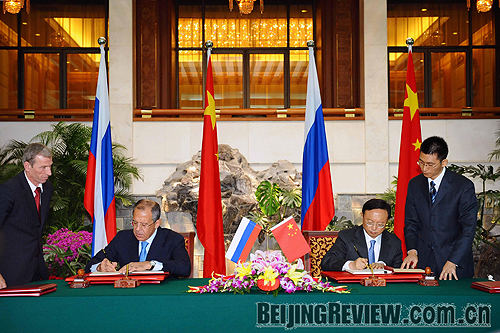|

WE AGREE: Chinese Foreign Minister Yang Jiechi and Russian Foreign Minister Sergei Lavrov finalize the resolution of the territorial boundary in Beijing on July 21
It has taken 40 years, and China and Russia have finally negotiated their way to a territorial dispute settlement. On July 21, Chinese Foreign Minister Yang Jiechi and his Russian counterpart Sergei Lavrov signed a treaty to settle their 4,300-km common border. The agreement concerns the eastern part of the border.
Describing the agreement as "positive and fruitful," Yang said that the Sino-Russian border would become a peaceful, stable and friendly example of the cooperation between the two peoples. Yang said that the two sides stressed they would support each other's core interests, which is the central component of bilateral relations. Lavrov said the settlement was based on developing long-term good neighborliness and the principles of equality, mutual benefit and respect.
Sheng Shiliang, an expert on Russia studies at the Development Research Center of the State Council, said in an International Herald Leader report on July 22 that, the settlement was a great success, condensing the wisdom of the two countries' top leaders. He said the way in which the border dispute was resolved could become a model for peacefully settling similar territorial issues worldwide. With a precondition of respecting history, this settlement has protected state interests and maintained territorial integrity, while admitting the existing situation to some degree. According to Sheng, some Japanese scholars have already indicated they would refer to this method of settlement to resolve their country's territorial disputes with Russia.
The newly signed agreement mainly concentrated on area around Heixiazi Islands, covering about 350 square km. Negotiations concerning the islands had lasted for decades, with each side constantly claiming historical evidence to prove their sovereignty. At the turn of the new century state leaders on both sides decided to solve the problem through peaceful negotiation, so as to eliminate issues that damage bilateral relations and further improve their ties.
Foreign ministries of the two countries began negotiations in 2000, and signed an agreement in 2004, with the two countries almost equally splitting the islands. A survey of the land area of the islands was completed in late 2007, and survey of the water area completed earlier this year.
| 